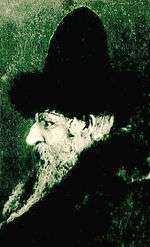Shtreimel

A shtreimel (Yiddish שטרײמל, plural שטרײמלעך shtreimlech) is a fur hat worn by many married Haredi Jewish men, particularly (although not exclusively) members of Hasidic Judaism, on Shabbat and Jewish holidays and other festive occasions.[1] In Jerusalem, the shtreimel is also worn by Yerushalmi Jews (non-Hasidim who belong to the original Ashkenazi community of Jerusalem, also known as Perushim). The shtreimel is generally worn only after marriage, except in some Yerushalmi communities, where boys wear it from the age of Bar Mitzvah.
Origins
While there is strong religious custom for Jewish males to cover their heads, from the standpoint of Jewish law there is no special religious significance to the shtreimel as compared to other head coverings. However, the wearing of two head coverings is considered to add additional spiritual merit, plus the presence of beautiful craftsmanship adds beautification and honor to the custom. The shtreimel is always worn over a kippah, or yarmulke.
There is much speculation surrounding the origin of the shtreimel. According to the Encyclopædia Britannica, it is of Tatar origin.[2]
Male Orthodox Jews can be highly conservative regarding headgear, and some traditional Jews still wear trilbys or homburgs. Such headgear is worn on special occasions (such as Shabbat), in the synagogue, or by office-holders such as rabbis and even where non-Jews in the country of origin have mostly stopped wearing it. The shtreimel is comparable in construction to fur hats worn by Eastern European and Russian nobility and royalty.
Types of shtreimels


The most widely seen shtreimel is typically worn by the Hasidim of Galicia, Romania, and Hungary, and was worn by Lithuanian Jews up until the 20th century. It comprises a large circular piece of black velvet surrounded by fur. The shtreimel of Menachem Mendel Schneersohn (the Tzemach Tzedek) was from white velvet. Hasidim originating from Congress Poland wear a high shtreimel (often called a spodik). The shtreimel of the Rebbes of the Ruzhin and Skolye dynasties is pointed upward.
Symbolism
According to Rabbi Aaron Wertheim, Rabbi Pinchas of Koretz (1726–1791) stated, "The acronym for Shabbos is: Shtreimel Bimkom Tefillin -- the shtreimel takes the place of tefillin."[3] Since wearing special clothing on Shabbat is a form of sanctification, among the Hasidim of Galicia and Hungary, the shtreimel is associated with the holiness of Shabbat, a crown such as that worn by royalty, which enhances and beautifies Shabbat.
Arnon asserts that the number of furs used in the manufacture of the shtreimel has some significance. Common numbers are 13, 18, and 26, corresponding respectively to the Thirteen Attributes of Mercy, the numerical value (gematria) of the word for life (Hebrew: חי), and the numerical value of the Tetragrammaton.[4] Contemporary shtreimlach may include higher numbers of tails. At least one maker creates shtreimelach with 42 tails, symbolizing the 42-letter Divine Name.
Manufacture
The shtreimel is typically custom-made for the intended wearer, of genuine fur, from the tips of the tails typically of Canadian or Russian sable, beech marten, baum marten (European pine marten), or American gray fox. The shtreimel is the most costly article of Hasidic clothing. It is possible to buy a shtreimel made of synthetic fur, which is more common in Israel. Usually the bride's father purchases the shtreimel for the groom upon his wedding. Nowadays, it is customary in America to purchase two shtreimels: a cheaper version, called the regen shtreimel ("rain shtreimel"), used for occasions where the expensive one may get damaged. In Israel, due to the economic circumstances of most members of the Hasidic community in that country, the vast majority of shtreimel-wearers own only one shtreimel. Manufacturers of shtreimels can be found in New York City, Montreal, Bnei Brak, and Jerusalem. The shtreimel manufacturers (shtreimel machers) keep their trade a closely guarded secret.[5]
Other clothing
The shtreimel is only worn in conjunction with other articles of clothing that comprise "Shabbos wear". It is never worn with weekday clothing.
While there are no official rules as to when the shtreimel is to be worn, it is usually worn on the following occasions:
- Shabbat
- Jewish holidays, including Rosh Hashanah, Yom Kippur, Sukkot, Simchat Torah, Shemini Atzeret, Purim, Passover, Shavuot
- (Chol HaMoed) of Pesach and Sukkot
- the evenings following the end of the above-mentioned days
- at one's own wedding, or those of family members or of members of one's Rebbe's family
- during the seven days following one's wedding, or of the wedding of a close family member (Sheva Brachot)
- at a brit milah
Some Hasidic Rebbes wear a shtreimel on occasions when their Hasidim will not, such as when lighting the menorah or when conducting a tish on Tu BiShvat and Lag BaOmer, whereas other rebbes may wear a kolpik on those occasions, and still others simply wear their weekday hat.
See also
References
- Notes
- ↑ Blumenthal, Ralph (2009-05-10). "When He Talks Hats, Basic Black is Only the Beginning". New York Times. ISSN 0362-4331. Retrieved 2009-05-11.
- ↑ Encyclopædia Britannica (1963) Volume 23 page 113
- ↑ Halachos V'halichos B'chasidus, p. 196
- ↑ Arnon, p.88
- ↑ Arnon p.208
- Bibliography
- Arnon, Dan (1995). A Hat for all Season. Tel Aviv: Am Oved. ISBN 965-13-1021-9.
- Philippi, Dieter (2009). Sammlung Philippi - Kopfbedeckungen in Glaube, Religion und Spiritualität,. St. Benno Verlag, Leipzig. ISBN 978-3-7462-2800-6.
External links
| Wikimedia Commons has media related to Shtreimels. |